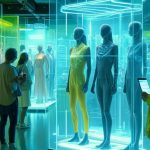The automotive industry is at a crossroads. Self-driving cars from companies like Waymo and Zoox are pushing a bold new future of mobility, shifting the conversation from individual ownership to shared robotaxi fleets. The promise of increased safety and efficiency is undeniable, but it presents a critical question for car manufacturers: Is the traditional idea of car ownership obsolete? The answer is no. While autonomous technology is making a real impact, the need and want for individual car ownership and the joy of driving yourself are still alive. The key is to combine this enduring desire with cutting-edge technology that seamlessly integrates into our daily lives. The car of tomorrow must be more than just a mode of transport; it must be a truly personalized and tech-rich experience that complements our lives.
The central tension currently facing the industry is a fundamental one: how to balance the push for automation with the enduring desire for personal control and the pleasure of driving. The rise of robotaxi services and the increasing maturity of Level 4 autonomous technology are significant external forces, making this problem critical right now. For instance, data from Waymo has shown a dramatic reduction in accidents compared to human drivers. These statistics highlight the scale and urgency of the technological shift, proving that this problem cannot be ignored. The challenge is that a future of complete automation, while offering safety benefits, also risks alienating a large consumer market segment that still values the driving experience.
The most common mistake companies make is assuming that the future is purely autonomous and that consumers will transition away from personal cars. This overlooks the deep emotional connection many people have with their vehicles.
Our Automotive AI Studio methodology, “The Personalized Driver Model,” provides a roadmap for how carmakers can avoid this pitfall and thrive in this new landscape. This framework is built on three pillars:
- Reinventing the Cabin Experience Through Software: The car’s interior should no longer be a static environment. It needs to be a dynamic, software-defined space that can be updated “over the air.” A driver should be able to change the entire look and feel of their dashboard, infotainment system, and even the ambient lighting with a simple software update. This ensures the car feels fresh and new long after it leaves the dealership, making innovations like theming a critical selling point for tomorrow’s buyers.
- Seamless Digital Integration: The vehicle must be an extension of our digital lives, not a separate silo. This requires deep technological integration with our smart homes, mobile devices, and work calendars. Imagine a car that knows your schedule and pre-heats the cabin on a cold morning, or a system that can be themed to match your mood or favorite sports team. This level of personalization is what tomorrow’s car buyer expects.
- The Best of Both Worlds: Tomorrow’s car buyer/user wants the option to be a driver when they want to be and a passenger when they need to be. The sweet spot is a car with advanced driver-assistance systems (ADAS) that provide partial automation for the daily commute but still allow for a thrilling manual drive on a scenic route. This approach respects the consumer’s desire for both convenience and control.
This methodology is not merely a theoretical concept; it has been applied successfully. A major car manufacturer (anonymized for this example) faced the challenge of customer feedback indicating that their car interiors felt dated after just a few years. By allowing customers to update their in-car experience through software, they were able to address this issue.
A recent J.D. Power’s 2025 U.S. Automotive Performance, Execution, and Layout (APEAL) Study shows a significant rise in the adoption rate of personalization in luxury cars and the subsequent increase in emotional satisfaction. This demonstrates that you can make a car feel new and exciting without changing the hardware. Our solutions aren’t just theory—they work in the real world.
The most significant risk for companies in the automotive industry that ignore this advice is becoming irrelevant. The next wave of disruption isn’t just about a self-driving car, but about the vehicle becoming an integral part of our digital ecosystem. While many are focused on the hardware race for full autonomy, tomorrow’s leaders are already preparing for a future where the driving experience is both a personal joy and a tech-integrated sanctuary. Ultimately, the car of the future needs to be a place of enjoyment and control for the driver, not just a utilitarian pod for getting from point A to B. The core question for leaders to reflect on is this: Is your organization building capabilities for the future, or are you just optimizing for the past? The single most important idea to remember from this article is that the joy of driving is not dying; it’s evolving, and the car manufacturers and future service operators that understand this will be the ones that succeed.
Learn more about innovation in the automotive industry and the future of mobility here.




